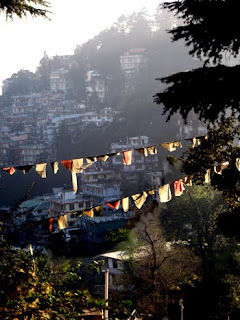Looking out the back side of the Pema Thang Guest House, I had a clear view of the Dalai Lama’s residence, and just beyond that, a 3000 ft. drop to the market in lower Dharamsala. McLeod Ganj is a tiny ridge, less than a mile long that sticks out of the first major Himalayan ascent into the clouds. Actually, on most days in winter, it’s above the clouds. Sometimes the entire world is obscured by low hanging haze, while McLeod basks in sunlight at 6000 ft.

The view from the back porch.

And the view out the front door.
Along this ridge there is no more open space as the entire spit is covered in hotels, restaurants, apartments, shops, taxi & bus stands and some government & NGO offices. Halfway down the impossibly steep Library road to Lower Dharamsala lies the Tibetan Government in Exile.

There's no more room left along the ridge, but builders continue to contruct into the sky and further down the valley.
As one makes their way down one of the four streets of McLeod Ganj you notice the town is as international as New York, Dubai, Hong Kong or London. You are just as likely to run into someone from Taipei as someone from Cedar Rapids. The majority of the town is Indian, but there is a large minority of Tibetan refugees and a smaller, but very noticeable, group of westerners. Noticeable because no other town of its size in the Indian Himalayas has more than a few lost Injies (whities!). Dharamsala and the surrounding area have more than a thousand.
It wasn’t just Delhi Belly that kept me from recognizing the town when I arrived. Since 2000 the town had gone through a major and needed growth spurt. The only negative effect I noticed was that many of the buildings had added on one to three stories which left the narrow streets sunless in the middle of the day.

They can build as high as they want, but they're still not going to obscure the peaks!
The other growth effects have made the place much more palatable. First of all the streets – all of them – had been paved and effective drainage put in effect. This, for me was the most reassuring sight since leaving the states. Although the opportunity to teach broadcasting to the kids at the Tibetan Children’s Village was something I couldn’t pass up, in the back of my mind was the fact that I didn’t survive my first stay in McLeod Ganj. In 2000, after two months of rolling along muddy roads chocked full of cow/dog/monkey/human urine & feces, I’d developed an infection that even powerful antibiotics could not get rid of. After battling it for a month I was forced to return to the states for better treatment. And even there, they couldn’t get rid of it. I just had to ride it out for a year until it finally just became part of my body.
Not only were the streets paved, but they were swept clean every day. As I took my first stroll into town I caught another, most welcoming sight – a garbage truck. In 2000 shop and restaurant owners simply tossed their trash into the street or out their back window down a ravine. One of the main entrances to the town was a festering garbage heap that gagged even the Indians who grew up next to it. It has since been replaced by the new McLeod Ganj bus terminal with (gulp) an accessible ATM! The hillsides that had a grating skin of plastic trash on them have been cleaned up and the old pockets of dump-funk air have all but disappeared.

Yup - an honest to god, GARBAGE TRUCK!
After my first roll around town, I realized I wasn’t going to battle my health this stay around. If I just kept my hands clean and used disinfectant goo before cathing, I was going to be able to simply go to work and concentrate on my job.
And what a freaking incredible job it is…




What an incredible view.
ReplyDeleteTom...love keeping up with your adventures...
ReplyDeletethis is awesome,
Go JETS!
Adam